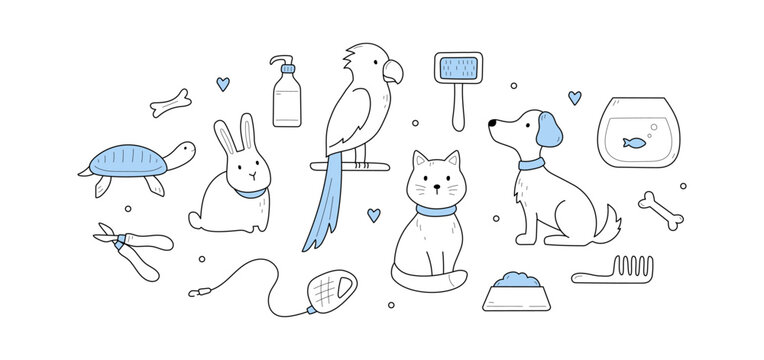Are you a cat lover looking to add a furry friend to your home, but worried about how your feline will react? Look no further! While many dogs have a reputation for being less than cat-friendly, there are some surprising breeds out there that not only coexist peacefully with cats but even embrace them as part of their family. In this post, we’ll introduce you to 10 surprisingly good dogs that could make the purrfect addition to your home with cats. Get ready to be pleasantly surprised!
Introduction: Finding the Perfect Dog for Your Feline Friend
Adding a dog to your home with cats can be a daunting task, but it doesn’t have to be. With the right breed and proper introduction, dogs and cats can live harmoniously together. Choosing the right dog is crucial to ensure that your feline friend feels safe and comfortable in their own home. It’s important to find a dog that has a gentle and calm demeanor, as well as one that is not prone to chasing or aggressive behavior towards cats. Good socialization skills are also key in ensuring that your new dog will get along with your cat. With patience, time, and proper training, you can create a happy and peaceful home for both your furry friends. In this article, we’ll explore the top 10 dogs that are surprisingly good with cats and provide tips on how to introduce them properly.
Top 10 Dogs That Are Surprisingly Good with Cats
Top 10 Dogs That Are Surprisingly Good with Cats**
Are you a cat parent looking to add a new furry friend to your home? Finding the right dog breed that can coexist peacefully with cats can be challenging. However, there are many breeds of dogs that make great companions for felines.
One such breed is the Bichon Frise, known for their sociable and gentle nature. They have a low prey drive and love being around people and animals alike. Another excellent choice is the Cavalier King Charles Spaniel, who is not only friendly but also adaptable to different living arrangements.
For those who prefer larger breeds, Great Danes are often overlooked as potential pets for homes with cats due to their size. However, they have a calm personality and are surprisingly docile around small animals.
Other good options include Beagles, Boxers, Bulldogs (English or French), Golden Retrievers, Labrador Retrievers, Pugs and Shih Tzus – all of which get along well with feline friends when socialized correctly.
When choosing a new pet dog for your home with cats it’s important to consider factors like temperament compatibility before making any decisions – click here for more insights on this topic!
Understanding the Temperament of Dogs and Cats
Temperament of Dogs and Cats
Before bringing a new dog into your home with cats, it’s important to understand the temperament of both animals. Dogs and cats have different personalities and communication styles, which can sometimes lead to conflicts.
Dogs are pack animals and tend to be more social than cats. They crave attention and affection from their owners and may become jealous if they feel neglected. On the other hand, cats are independent creatures who value their personal space and may become stressed if they feel threatened or crowded.
When choosing a dog that will be good with cats, look for breeds that have a calm and gentle temperament. Some breeds, such as Golden Retrievers and Beagles, are known for their friendly nature and ability to get along with other animals. It’s also important to consider the age of the dog – puppies may be too rambunctious for a cat while older dogs may be more mellow.
By understanding the temperament of both dogs and cats, you can choose a dog that will be a good fit for your feline friend.
Tips for Introducing a New Dog to Your Cat
Introducing a New Dog to Your Cat
Introducing a new dog to your cat can be a delicate process, but with patience and careful planning, it can be successful. The first step is to keep the dog and cat separated for a few days to allow them to get used to each other’s scents. This can be done by keeping the new dog in a separate room or using baby gates to create separate areas.
When it’s time for the initial introduction, make sure both animals are calm and relaxed. Keep the dog on a leash and let the cat approach at their own pace. It’s important to supervise their interactions closely and never leave them alone together until you’re confident they’re comfortable with each other.
Rewarding positive behavior is key during this process. Praise both animals when they exhibit good behavior around each other, such as sniffing or playing without aggression. If either animal shows signs of stress or aggression, separate them immediately and try again later.
Remember that every animal is different, so it may take some time for them to adjust to each other’s presence. With patience and consistency, your new dog and cat can become great friends in no time.
Common Mistakes to Avoid When Introducing Dogs and Cats
Not Considering Breed and Temperament Compatibility
One of the biggest mistakes that people make when introducing dogs and cats is not considering their breed and temperament compatibility. Some breeds have natural instincts to hunt or chase small animals, which could result in a disaster if you bring home a dog that has an incompatible temperament with your cat.
For example, high-energy dogs like Dalmatians or Jack Russell Terriers may be too much for a laid-back cat to handle. On the other hand, some breeds are known for being calm and gentle with cats, such as Golden Retrievers or Bichon Frises.
It’s important to do your research before bringing home a new dog to ensure they will get along well with your feline friend. Look for dog breeds that are known for being good with cats and consider adopting an adult dog who has already lived peacefully with cats in the past.
Introducing Dogs and Cats Too Quickly or Forcefully
One of the most common mistakes when introducing dogs and cats is doing it too quickly or forcefully. It’s important to remember that both animals need time to adjust to each other’s presence. Rushing the process can lead to aggression and stress for both pets. Instead, start by allowing them to smell each other’s scent through a closed door or baby gate. Gradually increase their interaction under supervision, rewarding positive behavior with treats and praise. Never force them to be in the same room or hold them together, as this can cause fear and anxiety. Patience and a gradual approach are key when introducing dogs and cats.
Neglecting to Properly Supervise Early Interactions
Neglecting to Properly Supervise Early Interactions between your new dog and cat can lead to disaster. It’s important to remember that dogs and cats have different communication styles and body language, which can lead to misunderstandings. Always supervise their interactions until you are confident that they can be left alone together. Don’t assume that just because your dog is friendly with other dogs, they will automatically be friendly with cats. Additionally, don’t force them to interact if they seem uncomfortable or scared. This can create a negative association between the two animals and make it harder for them to get along in the future.
Failing to Create Separate Spaces for Each Pet
One common mistake when introducing a new dog to your cat is failing to create separate spaces for each pet. This means that both pets should have their own designated areas where they can retreat and feel safe. It’s important to remember that dogs are naturally curious and may want to investigate the cat’s space, which could result in stress or aggression from the cat. Additionally, cats may not appreciate having their personal space invaded by a boisterous canine. To avoid any potential issues, ensure that both pets have plenty of private space where they can relax without feeling threatened or overwhelmed by the other animal’s presence.
How to Train Your Dog to Get Along with Your Cat
Dog training plays a critical role in ensuring that your furry friends can coexist harmoniously within the same home. Training your dog to get along with your cat requires patience, consistency, and positive reinforcement. Positive reinforcement techniques such as using treats or affection can help create a positive association between the two pets. When training, it’s important not to force interaction between the animals and to gradually introduce them under supervision. Encouraging playtime and exercises together can also help establish bonding and reduce any territorial behavior from either pet.
It’s essential to remember that each animal has its unique personality, which will influence how they relate to one another; some might take longer than others when it comes to getting acquainted with their new housemate. Therefore, you should practice continuous training even after successful integration for long-lasting harmony between your cats and dogs!
Conclusion: Choosing the Right Dog for Your Home with Cats
When choosing a dog to add to your home with cats, it’s important to consider the temperament of both animals. Choosing the right dog can make all the difference in ensuring a peaceful coexistence between your furry friends. Remember that every dog is unique, and what works for one household may not work for another.
Before bringing a new dog into your home, make sure to properly introduce them to your cat and follow the necessary steps for a successful introduction. Training your dog to get along with your cat is also crucial in maintaining a harmonious household.
Remember that patience and consistency are key when introducing dogs and cats. With proper preparation and training, you can create a happy home for both your furry friends.
In conclusion, introducing a new dog to your cat can be a bit nerve-wracking, but with the right temperament and proper introduction techniques, it can be a harmonious addition to your home. By choosing one of the top 10 dogs that are surprisingly good with cats and following our tips for introduction and training, you’ll have two furry friends living happily under one roof in no time.
If you’re looking for supplies or accessories for your pets, we invite you to visit our shop where we offer everything from food and toys to beds and leashes. Our knowledgeable staff is always ready to assist you in finding the perfect items for your furry companions. Don’t wait any longer – head over now to make both your pet’s lives even better!
Questions
Q: Who should consider getting a dog if they already have a cat?
A: Anyone who wants a furry friend duo! Many dog breeds get along well with cats.
Q: What dog breeds are good with cats?
A: Breeds like Golden Retrievers, Beagles, and Pugs tend to be friendly towards cats.
Q: How can I introduce my cat to a new dog?
A: Gradual introductions can help, such as keeping them in separate rooms and slowly allowing them to interact.
Q: Who should avoid getting a dog if they have a cat?
A: Those who have a cat with a history of aggression towards dogs should avoid getting a dog.
Q: What if my dog has a history of chasing cats?
A: Training and socialization can help, but it’s important to supervise interactions until you’re confident in their behavior.
Q: How can I make sure my cat and dog get along?
A: Providing separate food and litter boxes, ensuring each pet has their own space, and giving them equal attention and love can help.



